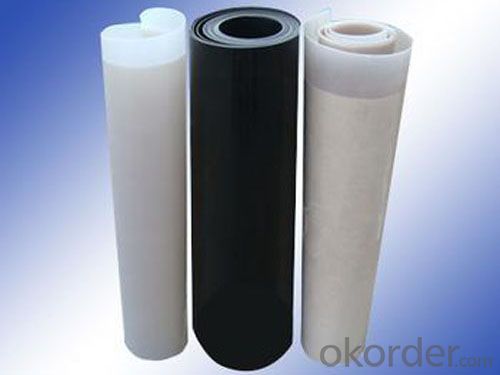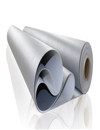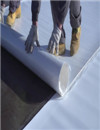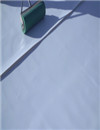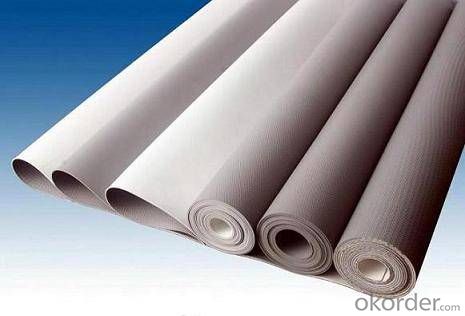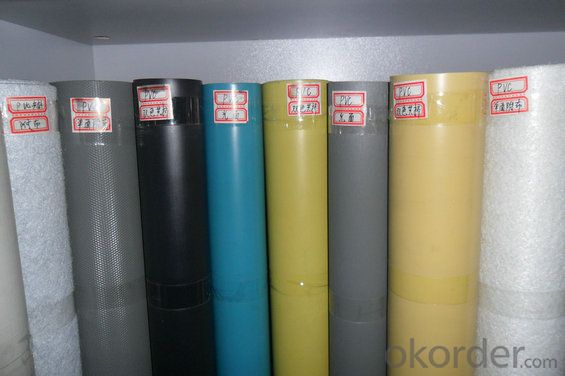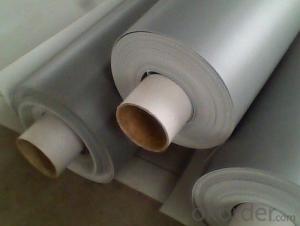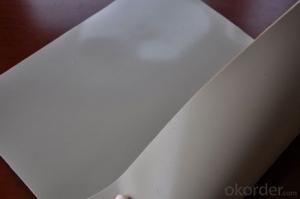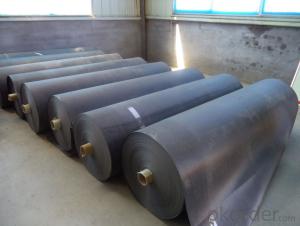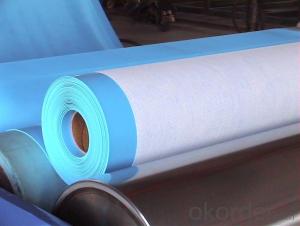EPDM rubber roofing waterproof membrane
- Loading Port:
- Qingdao
- Payment Terms:
- TT OR LC
- Min Order Qty:
- 20000 m²
- Supply Capability:
- 600000 m²/month
OKorder Service Pledge
OKorder Financial Service
You Might Also Like
Product Description of EPDM rubber roofing waterproof membrane:
EPDM waterproof membrane is of high elasticity among high polymer waterproof materials and becomes a world-popular waterproofing material. KEQIANG EPDM waterproof membrane is made from ternary ethylene-propylene rubber, which is designed for waterproofing of exposed and non-exposed applications. KEQIANG EPDM waterproof membrane production adopts the world-advanced equipment of cold feeding extrusion and continuous vulcanization technology.
Features of EPDM rubber roofing waterproof membrane:
·Excellent physical and mechanical performance
· High tearing resistance
· Good deformation adaptability
·High puncture resistance
·High aging resistance
·High UV resistance
Application of EPDM rubber roofing waterproof membrane:
l Roofs, Basement, Toilet
l Industrial and civil building waterproofing
l Geosynthetic liner for swimming pool, channels, irrigation system
l Especially suit for projects with high requirements in durability, anti-corrosion and deformation
Specification of EPDM rubber roofing waterproof membrane:
Type | EPDM Waterproof Membrane | |||
Material | EPDM Rubber | |||
Thickness | 1.0mm | 1.2mm | 1.5mm | 2.0mm |
Size | 1.2m(width) * 20m(length)/roll | |||
Type | Vulcanized | |||
Pattern | Non-reinforced(homogeneous) | |||
Packing | 24sqm--80sqm/roll, with plastic bag | |||
Color | Black | |||
Application | Roofs, basement, pond, Lake, steel structure roof, swimming pool, underground, tunnel, etc | |||

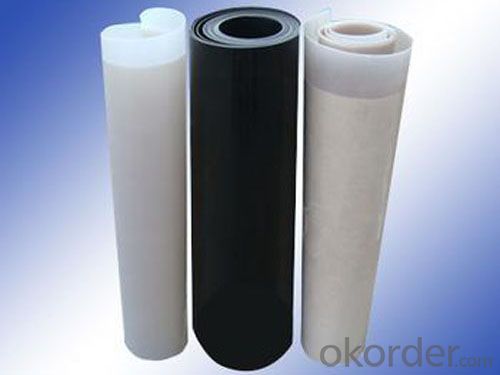
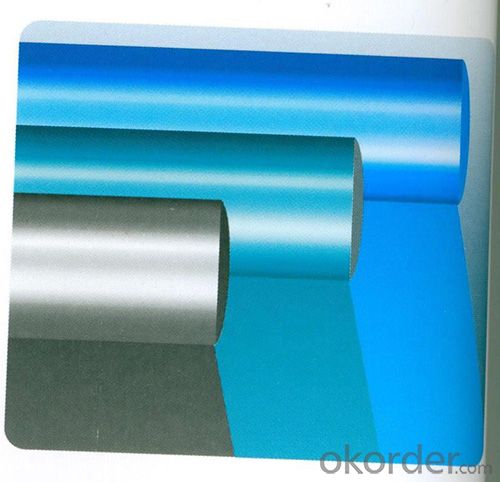
- Q: Can a waterproofing membrane be used on chrome surfaces?
- No, a waterproofing membrane is not suitable for use on chrome surfaces as it is designed to be used on porous materials such as concrete or wood to prevent water penetration. Chrome surfaces are already water-resistant, so applying a waterproofing membrane would be unnecessary and may damage the chrome finish.
- Q: What is the difference between SBS and APP rolls?
- First, SBS modified asphalt waterproofing membrane (polyester tire): Features: The use of polyester felt (filament polyester non-woven) mechanical properties, water resistance, corrosion resistance is also very good; elastic and low temperature performance has improved significantly, the effective range of (-25 ~ 100) ℃; Excellent fatigue resistance. Use: for high-level and high-rise buildings of the roof of the single-layer laying and composite use, can also be used for basement and other waterproof and moisture, more suitable for the northern cold areas and structural flexibility of the building waterproof.
- Q: Can a waterproofing membrane be used in areas with heavy foot traffic?
- Areas with heavy foot traffic can indeed utilize a waterproofing membrane. Many waterproofing membranes are explicitly engineered to endure extensive usage and mistreatment, thereby making them ideal for heavily frequented spaces like walkways, balconies, and parking decks. These membranes are typically constructed from robust materials such as rubber, PVC, or modified bitumen, which display resistance against wear and tear. In addition, certain membranes possess a surface that prevents slipping, thereby enhancing safety in walking zones. To guarantee enduring protection in areas with heavy foot traffic, it is crucial to carefully select a waterproofing membrane that suits the specific application and fulfills the necessary durability standards.
- Q: Can a waterproofing membrane be used for highway or road projects?
- Yes, a waterproofing membrane can be used for highway or road projects. Waterproofing membranes are commonly used in road construction to protect the underlying layers from water damage. These membranes act as a barrier against water infiltration, preventing water from seeping into the road structure and causing deterioration. They are typically applied on the bridge decks, tunnels, retaining walls, and other areas where water exposure is high. The waterproofing membrane helps to extend the lifespan of the road by preventing moisture-related issues such as cracks, potholes, and erosion. Additionally, it can enhance the durability and strength of the road structure, improving its resistance to environmental factors. Overall, the use of a waterproofing membrane in highway or road projects can provide long-term protection and ensure the longevity of the infrastructure.
- Q: Can waterproofing membranes be used in wet areas like bathrooms?
- Yes, waterproofing membranes can indeed be used in wet areas like bathrooms. In fact, it is highly recommended to use waterproofing membranes in bathroom areas to prevent water damage and leakage. These membranes are specifically designed to create a barrier against moisture, ensuring that water does not seep through the walls, floors, or other surfaces of the bathroom. By applying a waterproofing membrane, you can effectively protect the underlying structure from water damage, mold growth, and other issues caused by prolonged exposure to moisture. This is especially important in wet areas like bathrooms where water is constantly present. Waterproofing membranes are available in various forms such as sheet membranes, liquid membranes, and even pre-formed shower trays. They can be applied to walls, floors, shower enclosures, and other surfaces to create a watertight seal. It is crucial to properly install and maintain the waterproofing membrane as per manufacturer guidelines to ensure its effectiveness and longevity. Therefore, if you are considering renovating or building a bathroom, using waterproofing membranes is highly recommended to ensure a durable and moisture-resistant space.
- Q: Is a waterproofing membrane resistant to punctures or tears?
- Yes, a waterproofing membrane is designed to be resistant to punctures and tears. It is specifically engineered to provide a durable barrier that can withstand potential damage from sharp objects or external forces.
- Q: Can a waterproofing membrane be used for a retaining wall drainage?
- Using a waterproofing membrane is an effective method for retaining wall drainage. Typically used to prevent water from penetrating structures like basements or foundations, this membrane can also serve as a barrier against water seepage in retaining wall construction. Retaining walls are designed to hold back soil and prevent erosion, but without proper construction, they can be vulnerable to water damage. If water seeps through, it can create pressure behind the wall, causing structural problems over time. By installing a waterproofing membrane on the backside of the retaining wall, water infiltration into the soil and accumulation behind the wall can be prevented. Furthermore, a waterproofing membrane can help with the drainage of water away from the retaining wall. By incorporating drainage systems like weep holes or French drains, alongside the membrane, water can be directed away from the wall, reducing hydrostatic pressure and potential damage. It's important to note that while a waterproofing membrane can be used for retaining wall drainage, proper installation and compatibility with the specific retaining wall system and conditions are crucial. It's recommended to consult with a professional engineer or contractor experienced in retaining wall construction to ensure the most suitable approach for your specific project.
- Q: Are waterproofing membranes resistant to acid exposure?
- Waterproofing membranes can vary in their resistance to acid exposure depending on the specific type of membrane being used. Some waterproofing membranes are designed to be resistant to acid exposure, while others may not be. It is crucial to carefully select the appropriate waterproofing membrane for the specific application and environment where acid exposure may be a concern. It is also advisable to consult with manufacturers or industry experts to determine the best waterproofing membrane solution for acid-prone areas.
- Q: Can a waterproofing membrane be installed in areas with high humidity?
- Yes, a waterproofing membrane can be installed in areas with high humidity. In fact, high humidity can be a contributing factor to the need for waterproofing as it can lead to moisture buildup and potential water damage. Waterproofing membranes are designed to create a barrier against water penetration, regardless of the humidity levels in the area. However, it is important to ensure that the membrane is properly installed and sealed to prevent any moisture from seeping through. Additionally, it may be necessary to take extra precautions in areas with high humidity, such as using a moisture barrier or dehumidifiers, to further protect against potential water damage.
- Q: Can a waterproofing membrane be used in stadiums or sports complexes?
- Yes, a waterproofing membrane can certainly be used in stadiums or sports complexes. In fact, it is highly recommended to use waterproofing solutions in these types of structures to protect them from water damage and leakage. A waterproofing membrane acts as a barrier, preventing water from seeping into the concrete or other materials used in the construction of the stadium or sports complex. This is particularly important in areas where heavy rainfall or high humidity is common. By applying a waterproofing membrane to the roofs, walls, and foundations of these structures, it helps to ensure the integrity and longevity of the building, while also providing a comfortable and safe environment for athletes and spectators alike. Waterproofing membranes are designed to withstand the stresses and movements associated with the building, making them an ideal solution for stadiums and sports complexes. Additionally, modern waterproofing membranes are available in various forms, such as liquid-applied or sheet membranes, allowing for flexibility in application and compatibility with different construction materials.
Send your message to us
EPDM rubber roofing waterproof membrane
- Loading Port:
- Qingdao
- Payment Terms:
- TT OR LC
- Min Order Qty:
- 20000 m²
- Supply Capability:
- 600000 m²/month
OKorder Service Pledge
OKorder Financial Service
Similar products
Hot products
Hot Searches
Related keywords






